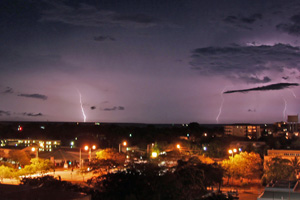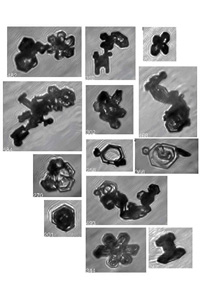ACTIVE Project-The Science Problem
The thermal structure of the tropical troposphere is determined by radiative-convective equilibrium up to 12-14 km, which is the level of outflow of most of the convective storms (Folkins 2002). Above this, the temperature continues to drop to a cold point around 17 km, but the frequency of convective penetration decreases with height and the atmosphere approaches radiative balance (Highwood and Hoskins 1998, Thuburn and Craig 2002). It therefore behaves as the base of the Brewer-Dobson circulation, determining the eventual composition of the global stratosphere. Below the tropical tropopause layer (TTL) convective processes dominate the vertical transport of chemical species. The vertical transport is fast and there are potential cloud-chemical processing effects. In the upper part of the TTL non-convective processes dominate and the corresponding vertical transport is slow. A key quantitative uncertainty in the TTL is the partition, as a function of height, horizontal location and season, between convective and non-convective transport.
Air transported by deep convection to the upper troposphere will have distinctive properties, compared with air transported by large-scale ascent. For a start, short-lived chemicals of land, marine or anthropogenic origin can be deposited virtually unchanged at high altitudes. The source gases for halogen radicals for instance (particularly bromine and iodine) could be transported in this way, affecting ozone concentrations in the TTL and, subsequently, the lower stratosphere (see Chapter 2 of WMO, 2002). The stratospheric impact of the halogen compounds depends on the interplay between the transport and the chemistry in the TTL, both of which are poorly understood. This interplay determines the degree of transformation that the source gases can undergo in the TTL, and how much bromine and iodine actually enters the stratosphere. Conversely, observations of some short-lived halogen compounds can reveal the origin of air transported by deep convection: CH3I is present in marine air, and so its presence in the TTL indicates recent marine convection (Cohan et al., 1999).

Lightning in deep cumulonimbi is a potent source of NOx radicals, and possibly also of ozone. Elevated NOx with hydrocarbons (VOCs) of ground-level origin provide a photochemical source of ozone in the upper troposphere. As ozone is an effective greenhouse gas in this region a better understanding of its chemistry is very important for climate modelling.
Crucial to our ability to forecast future climate change is a better representation of cirrus clouds in climate models. This in turn means understanding the density and nature of the cloud particles that are found in deep convective anvils, since deep convection is the major source of cirrus cloud in the tropics. This was the main thrust of EMERALD-II [../../emerald/]. However, in order to be able to calculate the crystal number concentration and sizes in the cirrus outflow from a thunderstorm, it is necessary to know the aerosol population, since it is from this population that the cloud condensation nuclei are drawn. There have been few measurements to date of the aerosol population associated with deep tropical thunderstorms, and models of convective transport of aerosols and chemicals are largely untested; although comprehensive studies of the microphysics of cirrus anvils were performed as part of the Cirrus Regional Study of Tropical Anvils and Cirrus Layers – Florida area Cirrus Experiment (CRYSTAL-FACE) during July 2002, the ACTIVE project focussed on the role of deep tropical convection on the aerosol and composition of the upper troposphere lower stratosphere (UTLS) region.

The life cycle of aerosol in the atmosphere remains uncertain. One picture involves the formation of fresh ultrafine particles in the outflow of rapidly uplifted air. The uplift causes significant aerosol loss through precipitation, but it also transports non-soluble gaseous precursors that can subsequently be oxidised to nucleate new ultrafine particles (Raes et al., 2000). The lack of surface area, cold temperatures and increased ion abundance close to the tropopause all favour new particle formation and the long residence times in the TTL allows for growth to several tens of nanometres where particles may participate in optical and cloud-forming processes. New particle formation in the TTL may well provide sufficient particle number to supply the lower stratospheric burden (Brock et al 1995). Twohy et al (2002) studied the outflow from anvils of a mesoscale cluster over the mid-western USA to investigate new particle formation in the outflow region. They found CO concentrations rising to 130 ppbv within the outflow, compared with 100 ppbv outside and CN concentrations increasing to 4 x 104 cm-3 within the outflow, more than an order of magnitude greater than outside it. Further, NO concentrations increased to 1500 pptv within the outflow compared to near zero outside. No measurements were made in the inflow region of the cloud but the study clearly demonstrated the effectiveness of deep convective clouds in transporting material (gases and particles) into the tropopause region followed by detrainment from the cloud by cirrus anvils. The study also presented strong evidence for the formation and growth of new sulphate particles in this region of the atmosphere.
It is well established that the black carbon content of atmospheric aerosols provides an important absorber of visible radiation in the atmosphere leading to local warming. The black carbon budget in the UTLS remains very uncertain, and whilst aircraft are a significant source, predictions show they do not provide the main source in the tropics where it is likely that convective transport of smoke from biomass fires provides a considerable source (Hendricks et al 2004). Recent measurements, with a single particle soot photometer, show considerably more black carbon in the Arctic stratosphere than has previously been measured (Baumgardner et al 2004). If these are correct the budgets must be substantially corrected and their role in warming the lower stratosphere will be significant. Previous to the ACTIVE project there were no such measurements in the tropics. If black carbon is mixed in the same particles as sulphate aerosol or dust, the sign of the resulting radiative forcing can be reversed, since the particles absorb as well as scatter. This points to a major difference between fresh and aged soot. Furthermore, black carbon can act as an efficient ice nucleus, affecting the ice crystal number and also its optical properties. Its distribution across the aerosol population will have an important bearing on the number of available IN in the TTL region.
At well as uncertainties in composition, there are significant inadequacies in current large-scale chemical transport models and chemical-climate models in the TTL. Firstly, the transition from convective transport dominating to non-convective transport dominating takes place over two or three km (i.e. only two or three grid points even in models with relatively high vertical resolution). Secondly, the velocity fields from meteorological datasets that are used to drive chemical transport models, both grid-based models and trajectory models, are likely to be poor in this region, in part because of the subtle mix of convective and non-convective processes. Slow vertical transport in non-convecting parts of the TTL is liable to be swamped by the effects of poor resolution and poor representation of these processes. Recent experience in DAMTP with trajectory calculations in the TTL based on ERA-40 3-dimensional velocity fields shows unrealistically large heating rates on many trajectories. Chemical measurements were made during ACTIVE to deduce with better accuracy the effect of large-scale transport, and disentangle this from convective transport.
Our overall picture of the TTL is almost certainly too simple - a consequence, in part of the small number of quality measurements in the region. Tuck et al. (2004) have recently pointed to the dearth of measurements of the horizontal structure of the TTL and to the inadequacy of conceptual pictures based on simple 1-dimensional (ascent/descent) treatments, confirmed by recent balloon measurements of tracers in the TTL by the Cambridge group. Based on flights in the northern tropics and sub-tropics, these point to a rich structure and variability. Tracer measurements from Darwin during 2005/2006 will allow the impact of the two different regimes on the structure of the TTL to be assessed. These represent an important new data set to complement the northern hemispheric data reported by Tuck et al. (2004).